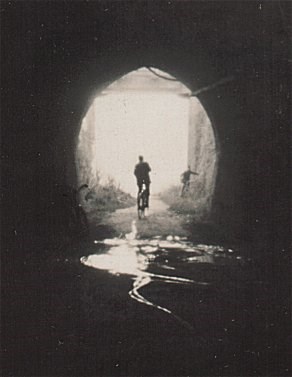Great Scenic View at Caversham Tunnel (Dndn,Otago) Letterbox Hybrid
Great Scenic View at Caversham Tunnel (Dndn,Otago)
-
Difficulty:
-

-
Terrain:
-

Size:  (regular)
(regular)
Please note Use of geocaching.com services is subject to the terms and conditions
in our disclaimer.
An easy offset-style letterbox hybrid cache taking you to one of Dunedin's hidden secrets - the 1873 Caversham Railway Tunnel, 865 metres long through solid Caversham sandstone, linking Caversham and the Kaikorai Valley. It's hoped that this cache will continue the good work of the previous cache in this spot: Light of Earendil.
The start coordinates are at the mouth of the railway cutting leading into the Old Caversham Tunnel. Access is from the Caversham Valley Rd (SH 1) pavement, about 240 metres uphill from the Barnes Drive intersection. Just duck in behind the wooden fence! Now either put the Light of Earendil coordinates into your GPS and follow the arrow, or else,
Follow these clues to reach the waypoint location:
- Pretend you're a south-bound train.
- Steam ahead through the cutting until you can go no further (choo-choo sound effects are optional).
- Find the waypoint at ground level (sorry,you will get dirty hands, but definitely no climbing required!)
NB: Take a pencil and paper with you - like a train wheel, you'll have to rotate before you reach your final destination.
 Photo: www.cavershamtunnel.org
Photo: www.cavershamtunnel.org
The building of the Caversham tunnel was an important step in Premier Julius Vogel’s controversial public works programme. Construction of the 150 m cutting and 865 m tunnel took 17 months. Tunnel breakthrough was on Thursday 26 September 1872; the inimitable rambler “Pakeha“ walked through the tunnel the following Saturday. He commented on the ingenious surveying system which enabled the headings to meet accurately “to an inch in line and level” in the Otago Witness 5 October 1872.
The first passenger service through the tunnel from Dunedin to the Green Island terminus was run on 1 July 1874, and a branch line from Burnside to Walton Park stared operating on 2 July 1874. (This supplied coal from the Saddle Hill coal mine; it's now a Ghost Railway.) By January 1879 the Main South Line from Christchurch to Invercargill and also the Lawrence Branch Line were completed, and the Otago Central Branch Line was under construction.
In 1910 the present Caversham Railway Tunnel, 1,407 metres long and the first double-tracked tunnel in the country, replaced this original tunnel. See the Caversham Tunnel site for more details of this tunnel's history.
 The ex-railway tunnel was a convenient commuter route between Caversham and Burnside (see Ian Gilchrist's 1948 photo - cyclist at Burnside end of tunnel). Apparently there was a trick to cycling through the unlit tunnel; you looked up at the tunnel roof where there was a line of reflected light, kept your eyes fixed on that line and pedalled as fast as possible!
The ex-railway tunnel was a convenient commuter route between Caversham and Burnside (see Ian Gilchrist's 1948 photo - cyclist at Burnside end of tunnel). Apparently there was a trick to cycling through the unlit tunnel; you looked up at the tunnel roof where there was a line of reflected light, kept your eyes fixed on that line and pedalled as fast as possible!
More recently, walking through the tunnel was an adventure for Cubs and youth groups (dropping the boys off at one end of the tunnel and the girls at the other end added to the fun).
The tunnel was closed in 2006 after a request to improve drainage in the Caversham cutting. Strangely enough, in the flurry of submissions, reports and media comment about reopening the tunnel no-one seems to have mentioned the most crucial imperative for needing walking and cycling access - to allow geocachers to look for Shelob's Hallway...
It seems appropriate to make this a "letterbox-hybrid" cache, even though the cache only contains a small store-bought stamp, because of the Otago Central Railway connection. Why not add another stamp to your Otago Central Rail Trail Passport?
Letterboxing is an outdoor hobby that combines orienteering with treasure hunting and puzzle solving. Letterboxers hide small, weatherproof boxes in publicly accessible places and distribute clues to finding the box in printed catalogues or by word of mouth. Individual letterboxes usually contain a notebook and a rubber stamp. Finders make an imprint of the letterbox's stamp, either in their personal notebook or on a postcard, and leave an impression of their personal stamp or sign their name in the letterbox's "visitors' book" as proof of having found the box and letting other letterboxers know who has visited. Many letterboxers keep careful track of their "find count". Letterboxing started at Dartmoor in England 150 years ago (Dartmoor Letterboxing) and there are also New Zealand letterboxers.
A geocaching "Letterbox Hybrid" does not necessarily involve following clues. It must contain a stamp and include significant GPS usage for at least part of the hunt.
Additional Hints
(Decrypt)
Gungpbeare